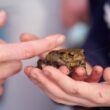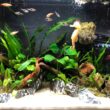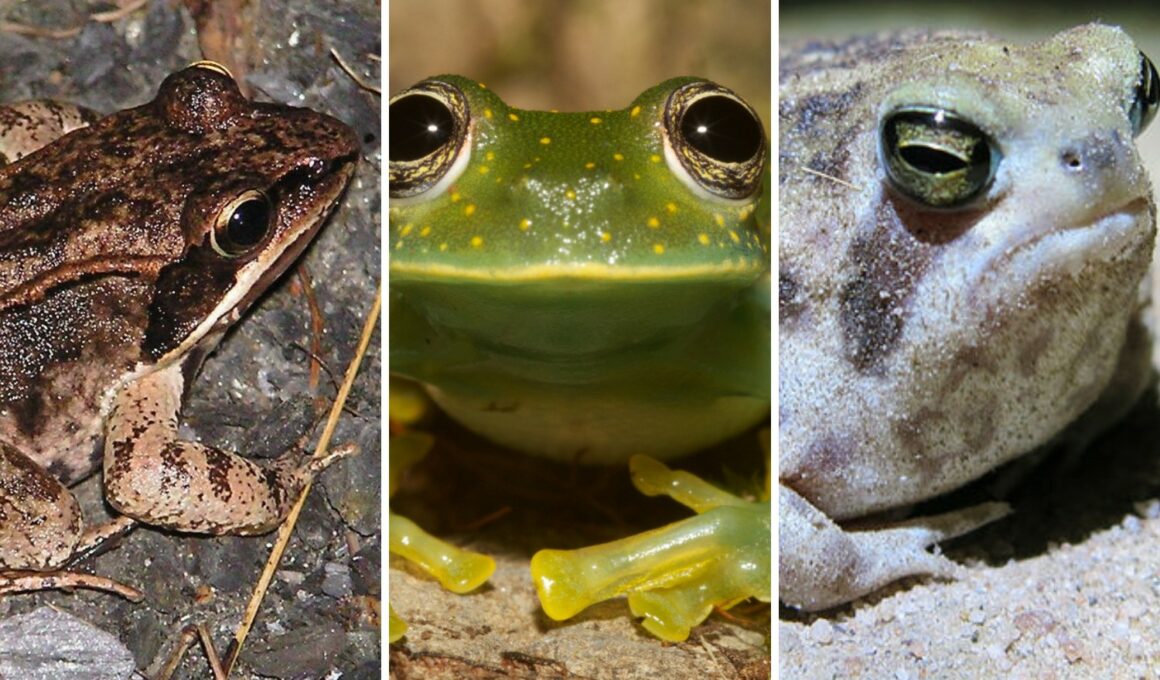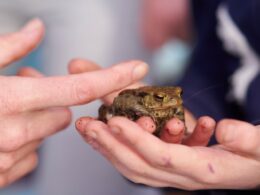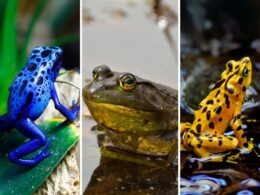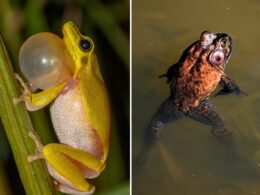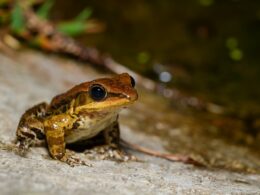In this article Show
Being a pet owner myself, I often find myself diving deep into the fascinating world of amphibians during my free time. There’s just something about these creatures that captivates me. And no, it’s not just their vibrant colors or the mesmerizing way they move. It’s their sheer diversity and the jaw-dropping abilities some of them possess.
Now, while not all of us might have a frog chilling in our living rooms, I bet many of you have paused to marvel at a frog hopping by a pond or have been intrigued by a documentary detailing their unique features.
Out of the thousands of frog species in existence, some truly stand out with abilities that could make even superheroes jealous.
So, buckle up as we hop (pun intended!) through seven of the most extraordinary frog species that boast super unique abilities. Trust me, by the end of this, you’ll be just as smitten with these creatures as I am.
1. Hairy Frog (Trichobatrachus robustus)
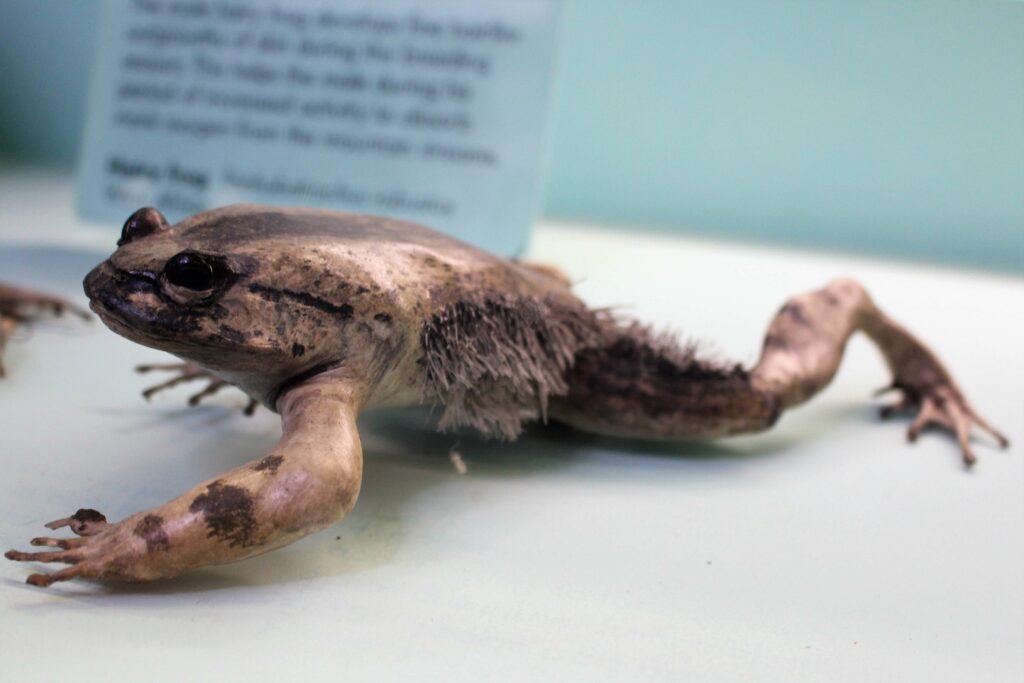
Description and Habitat
At first glance, you might wonder if this frog borrowed a fashion statement from our furry friends. The Hairy Frog, native to the dense rainforests of Cameroon and the Democratic Republic of the Congo, is a sight to behold.
Not actually “hairy” in the way mammals are, this frog gets its quirky name from the thin, hair-like structures that sprout from its thighs and flanks. These structures are especially pronounced in males, giving them an almost “woolly” appearance.
Unique Ability
Beyond its hairy facade, the Hairy Frog hides a feature that’s the stuff of comic book lore. When threatened, this frog can intentionally break its toe bones. Yep, you read that right.
These broken bones then pierce through the frog’s skin, forming sharp claws, almost like a real-life Wolverine from the X-Men! It’s a defensive mechanism like no other, allowing the frog to fend off would-be predators.
Significance in the Animal Kingdom
Such a dramatic and seemingly painful adaptation might have you scratching your head, wondering, “Why?” In the vast realm of the animal kingdom, it’s rare for a creature to intentionally inflict harm upon itself as a defense strategy.
This kind of adaptation underscores the intense pressures of natural selection and the lengths species might go to survive. It’s a testament to the wonders of evolution and how it crafts solutions to life’s challenges in the most unexpected ways.
If you ever needed a reason to respect frogs beyond their charming croaks and hopping antics, the Hairy Frog’s sheer grit and unique adaptation make a strong case. After all, how many animals can claim they grow their retractable claws?
2. Gliding Tree Frog (Agalychnis spurred)
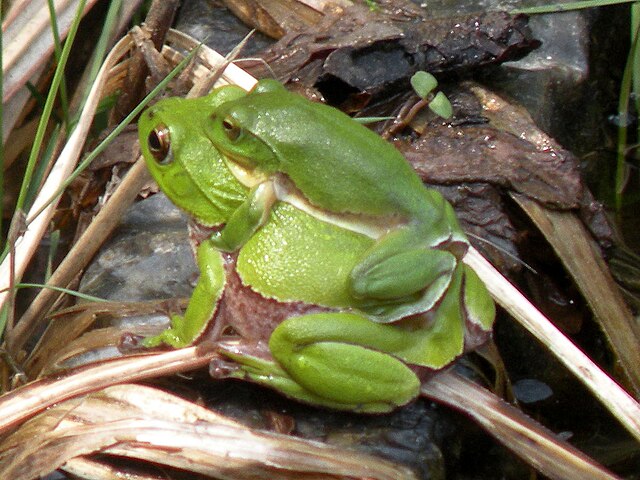
Description and Habitat
If you venture into the humid rainforests of Central and South America, especially during a twilight stroll, you might be in for a surprise. Amidst the green canopy, you might spot the Gliding Tree Frog – a beautifully colored amphibian with strikingly large eyes that seem to glow in the dark.
Their home? The treetops. These frogs rarely descend to the ground, preferring the high life amidst the leaves and branches.
Unique Ability
But what truly sets the Gliding Tree Frog apart is its incredible ability to take to the skies. No, they haven’t grown wings, but they’ve got the next best thing: extra-large, webbed feet. When leaping from branch to branch, these frogs spread out their webbed toes, which act like parachutes.
This nifty adaptation allows them to glide gracefully through the air, covering impressive distances as they move from tree to tree. It’s a sight that feels both surreal and magical – a frog that can practically “fly”.
Evolutionary Advantage of this Adaptation
You might be thinking, “Cool trick, but why glide?” This airborne maneuver offers several advantages. Firstly, it’s a quick escape route from predators. Instead of hopping from one branch to another (risking a misstep), a swift glide can put considerable distance between them and any lurking dangers.
Secondly, this ability allows them to effortlessly move between trees in search of food, mates, or new habitats without having to descend to the forest floor where more predators might await.
In an ecosystem where every second counts, the ability to glide gives the Gliding Tree Frog an edge, enabling it to thrive amidst the dense competition of the rainforest. It’s a vivid reminder of how nature, in its infinite wisdom, finds innovative ways for creatures to adapt, survive, and even thrive.
3. Surinam Toad (Pipa pipa)
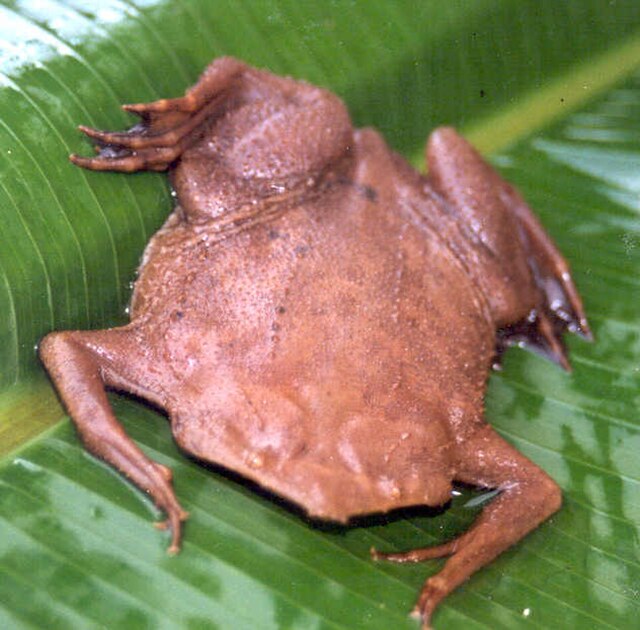
Description and Habitat
Dive into the freshwater bodies of the Amazon Basin, and you might encounter an amphibian that, at first glance, looks more like a fallen leaf than a living creature. The Surinam Toad boasts a flattened body, a triangular head, and a drab, mottled appearance, perfect for blending into its murky surroundings.
Largely aquatic, this toad prefers slow-moving water bodies like swamps, ponds, and calm streams where it can remain camouflaged and protected.
Unique Ability
The Surinam Toad’s true marvel, however, isn’t its appearance but its incredible reproductive strategy. Unlike most amphibians that lay eggs outside their bodies, the Surinam Toad showcases a skin-crawling yet fascinating spectacle. After a peculiar underwater mating dance, the female surfaces while the male attaches fertilized eggs to her back.
The skin then grows over these eggs, creating pockets where the eggs continue to develop. Over time, fully formed toadlets burst forth from her skin, making it seem like she’s “giving birth” through her back.
Reproductive Marvel and How It Differs from Typical Amphibian Reproduction
Most amphibians follow a relatively straightforward reproductive cycle: laying eggs in water, which then hatch into aquatic larvae (like tadpoles) before undergoing metamorphosis into their adult forms. The Surinam Toad, however, skips the free-swimming tadpole stage entirely.
By providing a protected environment on the mother’s back, these toads ensure a higher survival rate for their offspring, safeguarding them from predators and environmental threats.
This unique reproductive strategy is a testament to the diverse ways nature ensures species survival. In an environment teeming with predators, the Surinam Toad has evolved a method to give its offspring the best possible start in life.
For many, the birthing process of the Surinam Toad might seem eerie, but it stands as a powerful reminder of nature’s creativity and the lengths a species will go to protect its next generation.
4. Purple Frog (Nasikabatrachus sahyadrensis)
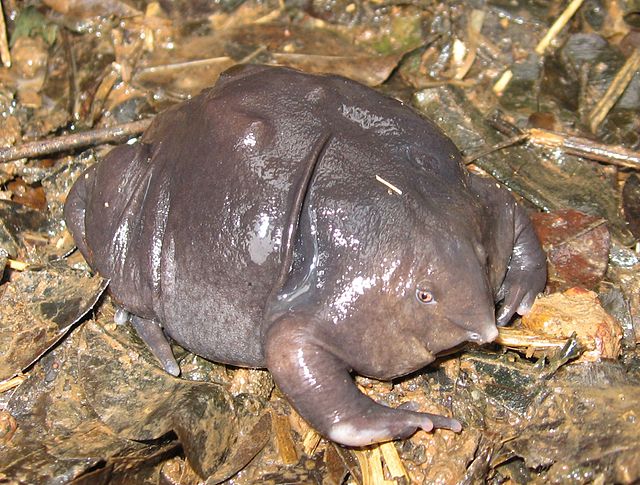
Description and Habitat
Nestled in the Western Ghats of India, one of the world’s biodiversity hotspots is a frog that remained hidden from science until the early 2000s. The Purple Frog, with its robust, bloated body and a peculiar pointed snout, certainly stands out. Its deep purple hue further distinguishes it from its more commonly known counterparts.
As for its habitat? Here’s where it gets intriguing – this frog spends the vast majority of its life underground, burrowed deep within the soil of these tropical forests.
Unique Ability
The Purple Frog is quite the recluse. Preferring the cool, dark embrace of the earth, it surfaces for a mere few weeks each year during the monsoon season. This is its time to mate, lay eggs in the freshwater streams created by the rains, and ensure the next generation.
Once this brief window of activity concludes, it returns to its subterranean hideaway, not to be seen until the next year’s rains.
Evolutionary Significance of Subterranean Adaptation
Life underground offers many advantages. The soil protects from predators, extreme weather conditions, and even desiccation during hotter months. It’s also a great place to find food, with the Purple Frog primarily feeding on termites and ants.
But the real evolutionary marvel is in the frog’s adaptations to this lifestyle. Its strong, muscular limbs are perfect for digging, and its pointed snout aids in moving through the soil. Furthermore, its unique vocalizations, which sound more like a chicken’s cluck than a typical frog’s croak, are well-suited for resonating underground, aiding in attracting mates even when buried deep.
This adaptation to subterranean life also sheds light on the frog’s evolutionary history. The Purple Frog, which belongs to a lineage separate from other known frogs, offers insights into the ancient Gondwanan landmass, hinting at how species evolved and diversified as continents drifted apart.
The Purple Frog’s story is a testament to nature’s ability to surprise us and adapt in the most unexpected ways. It serves as a poignant reminder that many of Earth’s wonders remain hidden, waiting to be discovered, and underscores the importance of conserving such biodiverse regions.
5. Desert Rain Frog (Breviceps macrops)
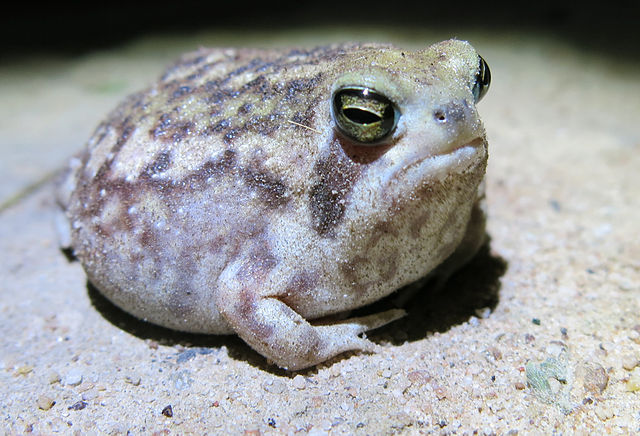
Description and Habitat
Now, let’s take a trip from the lush rainforests to the sandy stretches of the Namib Desert in Southern Africa. It’s an unlikely place to find a frog, right? Yet, this is where the Desert Rain Frog thrives.
These little amphibians, with their plump bodies and disproportionately large eyes, seem perfectly crafted for cuteness. Their skin, a sandy color with a slightly rough texture, provides a natural camouflage against the desert backdrop.
Unique Ability
But don’t let their adorable appearance fool you. When threatened, the Desert Rain Frog has a surprising trick up its sleeve. It belts out a vocalization that’s hard to describe – a kind of high-pitched squeak that seems incongruous with its serene habitat.
This unusual and unexpectedly loud call serves as a defense mechanism, startling potential predators and giving the frog a chance to escape. If you haven’t heard it yet, a quick online search might lead you to some amusing videos. It’s a sound you won’t forget in a hurry!
The Importance of Sound in Amphibian Communication
Across the amphibian kingdom, sound plays a pivotal role. For many, it’s a means to attract mates, stake out territory, or, as with our Desert Rain Frog, deter threats. These calls, each unique to its species, help frogs communicate across dense habitats where visual cues https://www.youtube.com/watch?v=cBkWhkAZ9dsbe limited. In the cacophony of a busy ecosystem, having a distinct and recognizable call ensures that the right message reaches the right recipient.
The Desert Rain Frog’s unusual call is more than just an internet sensation; it’s a testament to the versatility and importance of sound in the amphibian world. While it might tickle our funny bones, it serves a critical purpose in the life and survival of this remarkable desert dweller.
6. Glass Frogs (Centrolenidae family)
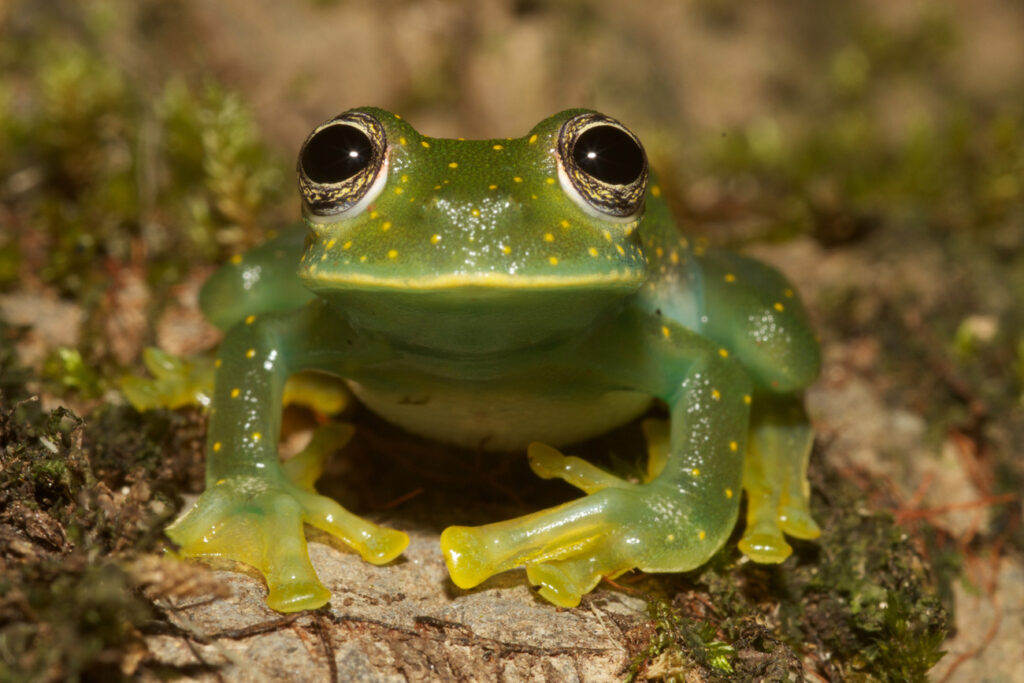
Description and Habitat
Imagine venturing through the lush, tropical rainforests of Central and South America, flashlight in hand, and spotting a leaf with something seemingly magical resting upon it. That’s the experience of encountering a Glass Frog.
These small, often greenish frogs belong to the Centrolenidae family, and their name paints a vivid picture of their most mesmerizing feature. Inhabiting areas near rivers and streams, they often perch on leaves and branches, blending seamlessly with their verdant surroundings.
Unique Ability
At first glance, Glass Frogs might seem like your typical tree frogs. But turn them over, and you’re in for a translucent treat. The undersides of many species in this family are almost completely transparent.
This see-through belly gives an unobstructed view of their internal organs, from the rhythmic beating of their heart to the coiling of their intestines. It’s a window into the intricate workings of a living creature, a sight that is both fascinating and humbling.
Significance and Evolutionary Reasoning for See-Through Anatomy
But why would evolution favor such an unusual feature? The transparent underbelly serves as an advanced form of camouflage. In the dappled sunlight of the rainforest, a transparent body can scatter light in ways that make the frog nearly invisible to predators lurking below.
Instead of seeing a tasty morsel, they see a mere shimmer, easily mistaken for a dew-covered leaf.
Moreover, this transparency might play a role in mate selection. In some species, males showcase their visibly beating hearts to prospective mates, possibly as a sign of their vitality.
The Glass Frog is a remarkable example of how nature, in its evolutionary wisdom, explores all avenues of adaptation. Their see-through anatomy isn’t just a quirky feature; it’s a sophisticated survival tool honed over millennia.
7. Wood Frogs (Rana sylvatica)
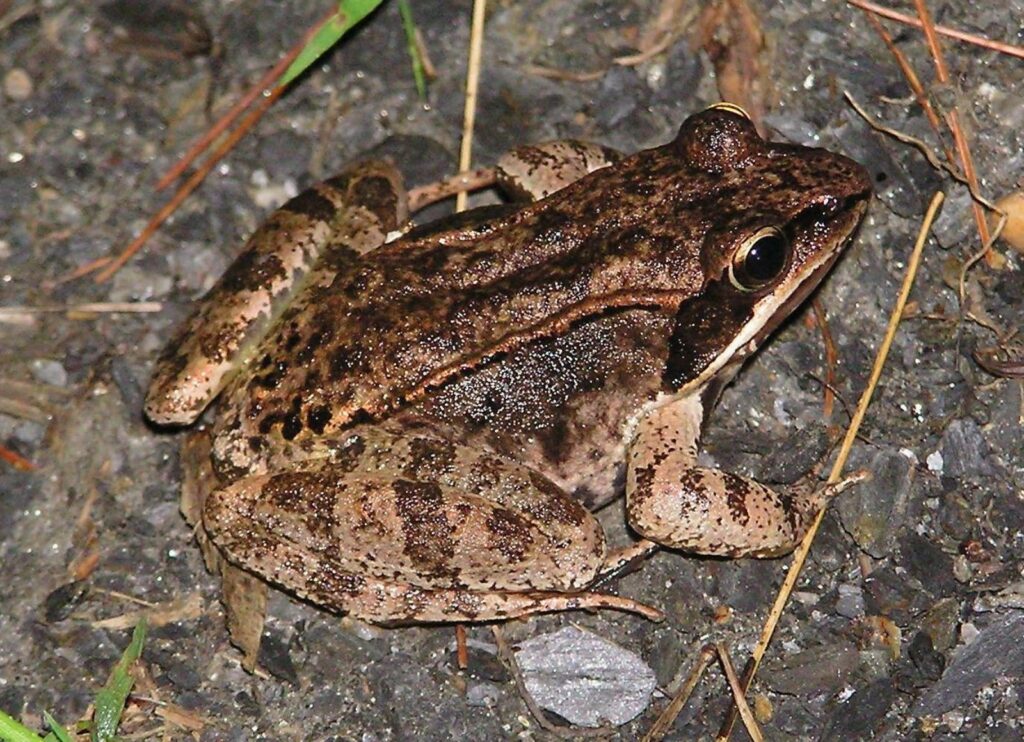
Description and Habitat
If you ever take a stroll through the woodlands of North America, from the southern Appalachians to the Arctic Circle, you might encounter a brownish frog with a distinct dark “mask” around its eyes.
Meet the Wood Frog, a species that seems as if it’s borrowed a page from a fairytale book. As the name suggests, these frogs are residents of forests, especially preferring moist, wooded areas with plenty of leaf litter and vernal pools for breeding.
Unique Ability
The Wood Frog’s claim to fame isn’t just its appearance or habitat but a jaw-dropping ability that seems straight out of a sci-fi novel. As winter approaches and temperatures drop, the Wood Frog does something unimaginable: it freezes solid.
Yes, like a popsicle! Its heart stops beating, its lungs cease to function, and most of its bodily processes halt. Yet, as spring’s warmth returns, the frog thaws and miraculously comes back to life, hopping away as if nothing happened.
Explanation of the Cryoprotectant Mechanism and Its Scientific Wonder
You might be wondering, “How is this possible without causing irreversible damage?” The answer lies in the Wood Frog’s production of cryoprotectants—a mixture of glucose and other compounds.
When freezing begins, the frog’s liver starts converting stored glycogen into glucose, which is then distributed throughout the body.
This glucose acts as a sort of natural antifreeze, preventing the cells from collapsing and ensuring they remain intact despite the freezing conditions.
The ability to freeze and thaw without damage is a scientific wonder. Researchers are studying this phenomenon not just out of sheer curiosity but also for its potential implications in fields like organ transplantation.
If we can understand and replicate this process, we might be able to preserve organs for transplantation for much longer periods, potentially saving countless lives.
Conclusion
Our journey through the astonishing world of frogs has taken us from the dense rainforests of Central America to the underground realms of India’s Western Ghats. Along the way, we’ve encountered species that freeze solid, glide through trees, and even give birth through their skin.
The sheer diversity and adaptability of these creatures underline the wonders of evolution and the myriad ways life manifests on our planet.
Each unique ability we’ve explored isn’t just a fascinating tidbit but a testament to the intricate balance and interplay of life on Earth. These adaptations have been honed over millennia, sculpted by the relentless forces of nature, and serve as a reminder of the delicate balance that sustains life.
However, as wondrous as these creatures are, they also face significant threats. Habitat destruction, climate change, pollution, and more put these marvels at risk.
The tales of these extraordinary frogs underscore the importance of conservation. Each species lost isn’t just a number on a list but a unique story, a distinct thread in the tapestry of life that can never be replaced.
Let’s take inspiration from the resilience and adaptability of these frogs and rally behind conservation efforts. By preserving their habitats and ensuring their survival, we’re not just saving frogs; we’re preserving the rich, intricate stories of life on Earth.



